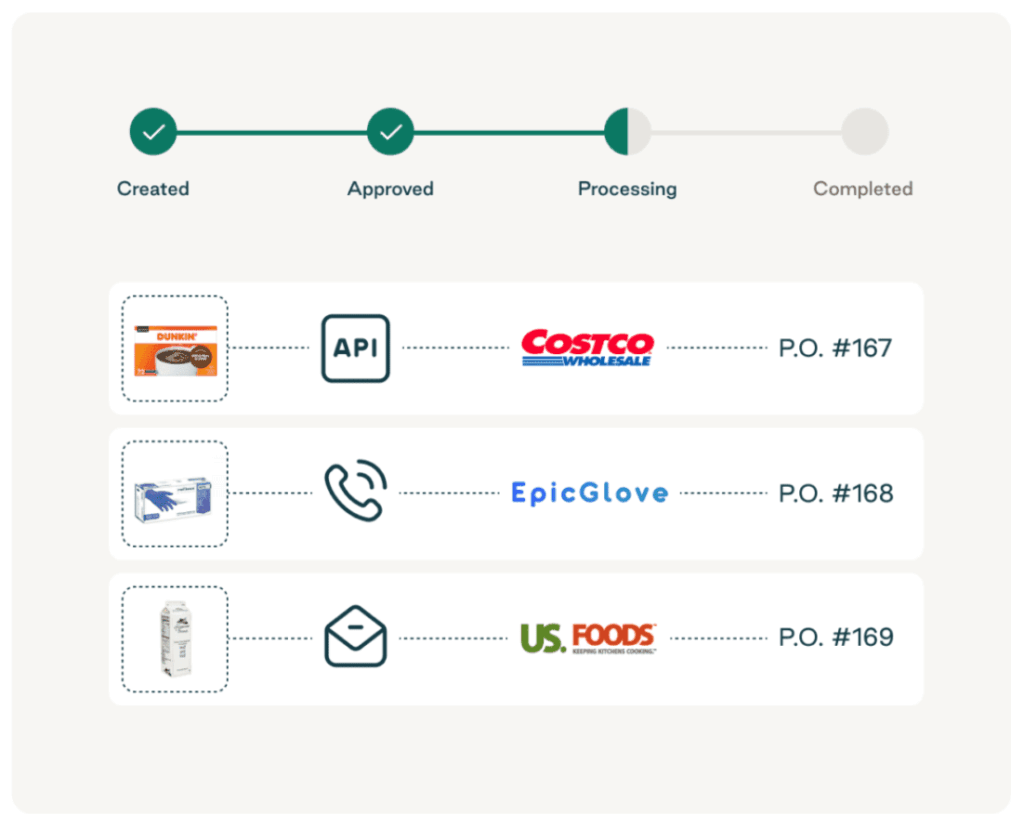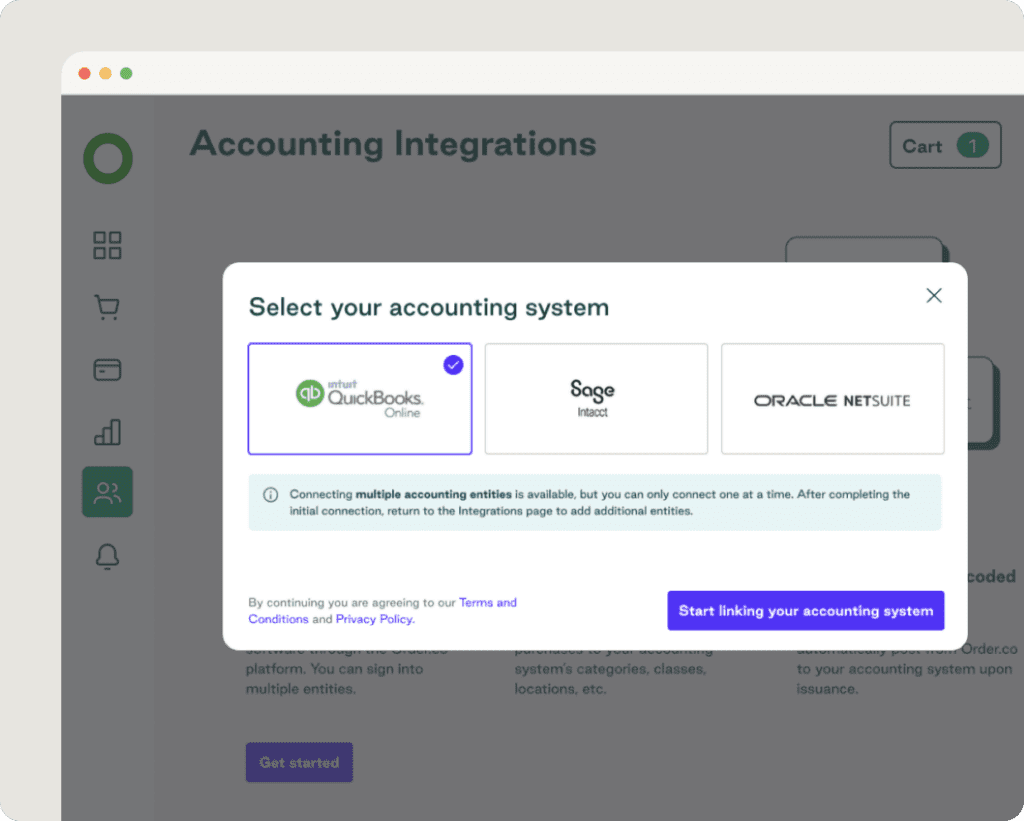Cost-Effective Strategies for Procurement Management in 2025

Cost-Effective Strategies for Procurement Management in 2025
The procurement function plays a critical role in every company’s financial health and performance, even in If you're managing procurement for a growing business, you know the frustration: What started as simple buying decisions now means juggling multiple vendors, chasing approvals, and sorting through stacks of invoices. You're spending more time on paperwork and less time on work that actually matters, all while rogue spend quietly chips away at your budget. As your business grows, these inefficiencies only get worse—leading to bloated budgets, missed savings, and compliance risks that are hard to untangle.
The fix is getting organized about how you manage procurement. With the right strategy and systems, you can take control of purchasing workflows, consolidate vendor relationships, and gain real-time visibility into spend. You reduce manual effort, enforce policy from requisition to payment, and free up time for more strategic priorities.
Procurement management is about much more than saving money. It's about building systems that scale as you grow. When you understand the fundamentals and get support from the right tools, you turn procurement from a daily headache into something that actually helps your business succeed.
Download the free guide: Spend Analysis Toolkit
What is procurement management?
Procurement management is the process of sourcing goods and services, approving purchases, tracking spend, and optimizing how your organization buys. Your procurement team's primary goal is to reduce bottom-line costs while improving the way your business acquires the resources it needs.
A strong procurement management process typically includes:
- Resource planning
- Supplier sourcing and evaluation
- Purchase requisition approval
- Purchase order processing
- Order reconciliation
- Vendor payment processing
Procurement also plays a critical role in meeting broader business needs. Even if you treat procurement and supply chain management (SCM) as separate functions, they share common goals: cost control, operational efficiency, and risk mitigation. Intelligent procurement helps you find reliable vendors, secure goods that meet your quality standards, avoid delays, and maintain greater control over spend.
The importance of procurement management
A solid procurement management strategy is your first line of defense against rising costs and unstable cash flow. It provides the foundation for more accurate budgeting and forecasting, ensures more efficient use of revenue, and creates more room to invest in business growth for long-term stability.
To build a procurement management system that supports smarter spend and stronger operations, prioritize:
- Strategic sourcing: Commit to vendor management in your procurement management plan to identify the best potential suppliers based on price, quality, and terms. A curated list of pre-vetted partners reduces research time and allows you to leverage negotiated pricing and mutually beneficial partnerships for better outcomes.
- Purchasing optimization: Formalize your purchase requisition and approval workflows to improve efficiency and reduce delays. An optimized procurement process helps your team move requests through review and approval quickly to keep purchasing on track.
- Waste reduction: Eliminate maverick spend (unauthorized or unmanaged purchases) that can quietly drain your budget. Tracking spend closely helps you eliminate process gaps and enforce procurement policies to minimize waste.
- Risk management: Mitigate supply chain, contract, and vendor risks by standardizing your procurement process. A consistent approach reduces exposure to disruptions, disputes, and reliability issues. It prevents costly emergencies like stock-outs, shipping delays, and supplier failures.
6 best practices for better procurement management
Procurement management requires dedicated resources, clear processes, and consistent metrics tracking to ensure accuracy and scalability. But refining your procurement practices doesn’t have to be complex.
Use these techniques to improve your procurement strategy for better results:
1. Use spend analysis to optimize cost
Spend analysis helps uncover savings opportunities across the entire procurement cycle by reviewing data from invoices, contracts, receipts, and purchase orders. It gives you clear visibility into how you use resources, helping you track supplier performance, identify cost-efficient alternatives, and make smarter negotiation decisions. That insight strengthens strategic sourcing, reduces waste, and boosts operational efficiency.
2. Centralize your procurement process
Centralizing procurement gives you a comprehensive view from request to delivery via real-time tracking and reporting. Greater visibility helps you identify opportunities for improvement so you can respond faster to minimize disruptions. A centralized platform also reduces manual work tied to purchase orders, invoicing, and payment tracking to minimize errors and save time.
Modern procurement software like Order.co lets you manage the entire procurement process in one place. It helps you control costs, customize workflows, and improve forecasting for better results.
3. Automate and document wherever possible
Documenting your procurement management process establishes standards for all procurement activities, including spending, purchasing, and performance measurement. It keeps stakeholders aligned, prevents maverick spend, and creates an audit trail to support regulatory compliance.
When you pair thorough documentation with automation, you reduce human error and improve overall system efficiency. Automating repetitive tasks like purchase order creation, approvals, three-way matching, and reconciliation frees up time for higher-value initiatives.

4. Integrate tools for smooth management
Connecting procurement data with other financial systems gives your team access to accurate, up-to-date information across platforms. With unified data, you can make faster, more informed decisions while reducing redundant processes and manual data entry errors.
For example, integrating accounting software like QuickBooks with your centralized eprocurement solution improves the accuracy and efficiency of purchasing, invoicing, and financial reporting. Instead of switching between disconnected tools or updating records by hand, you can sync data automatically and keep workflows running smoothly.

5. Manage your vendor lifecycle
A vendor lifecycle management program helps you monitor your suppliers’ performance by analyzing data on past purchases, delivery times, and order costs. This insight lets you reward vendors who deliver value and quality service with more business, while helping identify underperforming suppliers you can replace.
Vendor lifecycle management also simplifies vendor onboarding by centralizing all relevant supplier details, enabling faster order processing after vendor approval. Automated offboarding removes access privileges and archives related records, making transitions much easier.
6. Measure performance to control spend
Measuring performance is crucial for driving ongoing procurement improvements. Vendor scoring helps you evaluate supplier performance based on criteria like quality, delivery time, and pricing. By tracking procurement KPIs like invoice accuracy, order turnaround time, and policy compliance, you can uncover process gaps and opportunities for improvement. This allows you to forecast expenses, control costs, and allocate resources more effectively.
You can also use analytics to assess supplier risk. By evaluating factors like financial stability, regulatory compliance, and geopolitical exposure, you can identify vulnerabilities and take proactive steps to avoid disruption.
Download The Complete Guide to Procurement Management KPIs to learn how to measure what matters and turn data into savings.
Why should you automate procurement management?
Procuring goods and services is one of an organization's most significant financial activities. It’s no surprise that 56% of procurement leaders automate manual processes to control costs and improve efficiency.
Understanding your procurement spending is essential for reducing expenses and improving budget accuracy. But conducting these practices across dozens of vendors and hundreds of monthly invoices is a tall order.
Procurement automation helps you overcome this challenge while delivering additional money-saving benefits, including:
- Increased focus on strategic work: Intelligent procurement management helps procurement professionals and supply chain team members spend more time on high-impact tasks. This includes data-driven decision-making, strategic project management, and capacity planning—leading to better ROI and more efficient spending.
- More efficient payment processes: Automation lets you batch, process, code, and issue multiple payments simultaneously. This reduces processing costs and helps your purchasing department take advantage of early payment discounts.
- Improved contract management: Efficient procurement contract management and vendor lifecycle tracking improve accountability for the quality of goods and services purchased. Automating payment workflows speeds up processing and benefits both your organization and your suppliers.
What to look for in a procurement management software solution
If you are considering automated procurement software to improve your operations, a thorough evaluation process will help you select the right solution. Your current procurement management system, monthly invoice volume, tech stack, and typical procurement activities all influence which supplier will be best for your company's needs.
The platform you choose should offer features like:
- Full integration options: The right automated procurement platform will integrate with your larger financial or accounting infrastructure. Look for solutions that share data across systems to reduce duplication, errors, and manual work.
- Robust analytics tools: A strong procurement platform will let you leverage your data to support informed decisions and cost-savings analysis. Seek out software with advanced reporting and visualization tools that deliver real-time insights by location, category, product type, and general ledger (GL) code.
- Budget controls: A solution with automated purchasing controls simplifies the purchase requisition process while aligning spending with organizational goals. Choose a platform with dynamic budget controls and approval workflows that let your team manage limits by dollar amount, role, location, or other key parameters to enable self-service without sacrificing oversight.
These features give you the flexibility to create efficient procurement workflows and share financial information across your entire organization. Order.co combines automation, centralized management, and real-time visibility in a single platform designed to modernize and scale your procurement operations.
The added advantages of managing procurement with Order.co
If you’re struggling with scattered vendors, manual approvals, and invoice processing that's draining your time and budget, a comprehensive procure-to-pay platform can transform your procurement management process. By centralizing and automating your sourcing, purchasing, and vendor oversight activities, you reduce complexity, improve visibility, and gain better control over spend to help your business grow.
Order.co dramatically transforms procurement by:
- Creating a unified experience: Order.co lets you purchase across all your suppliers in one checkout cart through a curated catalog of preferred partners. Instead of juggling multiple supplier relationships separately, you can consolidate suppliers and use AI-powered sourcing engines to find cost-effective alternatives that optimize spend.
- Automating the procurement process: Order.co manages everything from purchase requisitions and automated PO generation to customizable approval workflows and order tracking. The platform provides real-time spend visibility and reporting, ensuring compliant and accurate outcomes.
- Simplifying payments and accounting: Order.co offers flexible financial offerings, including capital advances, net terms, and virtual cards. Automated invoice management, three-way matching, and accounting system integrations eliminate manual data entry and provide precise financial control.
Request a demo of Order.co to see how you can transform your procurement operations and spend optimization today.
Get started
Schedule a demo to see how Order.co can simplify buying for your business.
"*" indicates required fields



